Windows
 From our earliest times, the need for light has been central to our needs as humans. Letting light into a cave or crude structure allowed its inhabitants to better perform tasks and navigate their surroundings, alerting them to the day’s cycle and keeping them in sync with it – something that we now understand is vital to human health and emotional health and wellbeing.
From our earliest times, the need for light has been central to our needs as humans. Letting light into a cave or crude structure allowed its inhabitants to better perform tasks and navigate their surroundings, alerting them to the day’s cycle and keeping them in sync with it – something that we now understand is vital to human health and emotional health and wellbeing.
In England pre 16th century, most windows were of stone or timber construction with unglazed openings that could be covered in various ways: oiled cloth, paper, shutters, or even thin sheets of horn. Glazed windows were reserved for those buildings of the highest stature, and they were generally small panes of glass set in lead strip latticework. With the 16th century came the Tudor dynasty and a greater degree of prosperity. Windows became larger, and more prosperous households used window size and extravagance as a means of displaying their wealth. While glazed windows were still rare in smaller, more humble homes, their use was definitely on the rise.
In the 17th century Europe, the Italian Renaissance had a strong influence on window shape; a trend that would make its way to England. Windows became taller than they were wide and were often divided into four by a mullion and transom. As timber frames came into fashion, the mullion and transom became narrower and glazing was placed near-flush with the exterior window face – allowing for larger glazed areas with less visible frames.
The sash window was also introduced in the 17th century as a result of the introduction of crown glass. However, because crown glass was so expensive to produce, the most popular type of window remained casement with leaded glazing. However, over the 18th century, sash design evolved, glazing bars became thinner, and window size became more standardized, with the six over six being the most common arrangement.
 The 19th century brought with it some experimentation in an effort to move away from simple grid-style arrangements. This included narrow margin lights that were often filled with coloured glass. Glazing bars also took on a curved shape to mimic Gothic design. Advancements in glass making meant window size also began to grow. The existence of plate glass meant that fewer glazing bars were needed, and improved manufacturing methods meant that glazed windows were more affordable.
The 19th century brought with it some experimentation in an effort to move away from simple grid-style arrangements. This included narrow margin lights that were often filled with coloured glass. Glazing bars also took on a curved shape to mimic Gothic design. Advancements in glass making meant window size also began to grow. The existence of plate glass meant that fewer glazing bars were needed, and improved manufacturing methods meant that glazed windows were more affordable.
Also notable for this century was the rise in popularity of two window styles: Arts and Crafts and Queen Ann. Arts and Crafts brought with it a return to leaded lights set in timber or stone mullions, while Queen Ann favoured sash windows painted white, usually with the bottom sash being single paned whilst the upper sash featured several smaller panes. By the end of the century, the differences between the two styles blurred, and it became common to see both styles within the same building and sometimes within the same window.
Queen Ann and Arts and Crafts stylings continued to evolve into the 20th century. In housing estates, design became simplified while public buildings favoured windows that imitated late 17th and early 18th century stylings. All of this was in conjunction with the rise of the modernist window, which was a “crisp”, simplistic, functional piece manufactured using the very latest in technology.
When glass was discovered in Roman-occupied Egypt, it wasn’t only used for decoration but to form small panes that were then set into those openings.
Glass
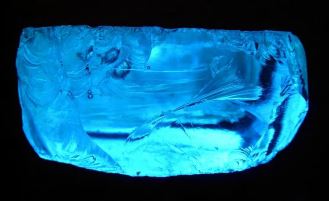 The use of glass itself goes back to our earliest history, where obsidian – a form of natural glass created by sand melting in the intense heat of a volcano and distributed during an eruption – was used to make spear tips. The existence of manmade glass can be traced back to 4000 BC, where it was used as glazing for stone beads. The first glass container is believed to have been made around 1500 BC. It was constructed by adding a layer of molten glass to a core made of sand.
The use of glass itself goes back to our earliest history, where obsidian – a form of natural glass created by sand melting in the intense heat of a volcano and distributed during an eruption – was used to make spear tips. The existence of manmade glass can be traced back to 4000 BC, where it was used as glazing for stone beads. The first glass container is believed to have been made around 1500 BC. It was constructed by adding a layer of molten glass to a core made of sand.
From 100 BC, glass blowing was the most popular way to make glass containers. The glass produced during this century was poorly suited for window applications because the impurities in the raw materials made it densely coloured. However, by the end of the first century AD, colourless glass was being produced.
During the years of Roman domination, the secret to making glass was closely-guarded. It wasn’t until the fall of the Roman Empire that the skill became accessible to wider Europe and the Middle East.
The first evidence of a glass industry in Britain dates back to 680 AD in the area around Wearmouth and Jarrow in the North of England. By the 1200s, the industry had spread to include areas around the Weald, Surrey, Sussex and Chiddingford.
Glass in windows
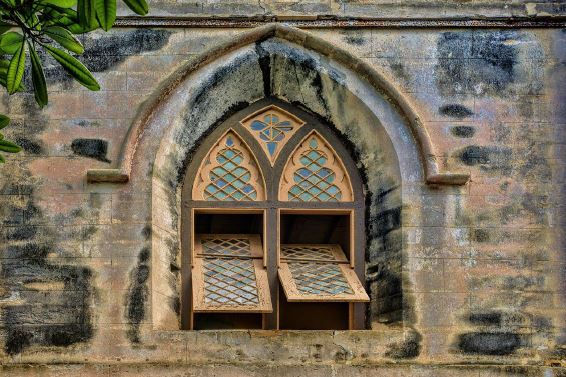 When glass was discovered in Roman-occupied Egypt, it wasn’t only used for decoration but to form small panes that were then set into those openings. When Rome occupied Britain, they brought glass making with them.
When glass was discovered in Roman-occupied Egypt, it wasn’t only used for decoration but to form small panes that were then set into those openings. When Rome occupied Britain, they brought glass making with them.
To make window glass, the Romans started with a long balloon of blown glass. They cut off the ends and split the resulting cylinder into two. The half cylinder
would be placed on an iron plate and flattened. This manufacturing process meant that openings were limited to a small size, but that changed in the 17th
century when, in England, a process for making large panes of glass was discovered.
Unfortunately, this breakthrough didn’t benefit the English when it came to windows in their homes because, in 1696, William III introduced a “window tax”. People were required to pay between two and eight shillings a year, depending upon the number of windows in their houses, and many bricked over their windows in order to avoid the charge. (William’s window tax is where the term “daylight robbery” originates from.) The tax remained in place for 156 years, with the levy-free window allowance going from 10 to six and then to eight. The tax was finally repealed in 1851.
Polished plate glass was introduced to Britain in the late 18th century; however, the production process was so expensive that it was only used for windows in the best rooms of larger, more expensive homes.
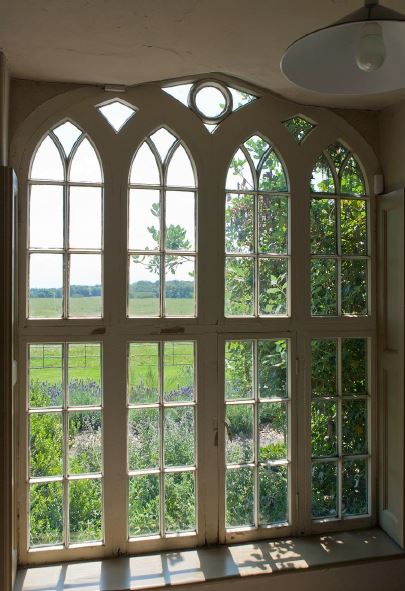 When, in 1834, a cylinder sheet process for glass-making was imported from Germany, Britain was able to produce higher quality glass in larger sheets far less expensively than previously-used methods. That combined with the withdrawal of the window tax meant that the price of glass was greatly reduced and more people could afford to have windows in their homes. This included opaque glass which, by 1888, was primarily patterned and produced by machine rolling.
When, in 1834, a cylinder sheet process for glass-making was imported from Germany, Britain was able to produce higher quality glass in larger sheets far less expensively than previously-used methods. That combined with the withdrawal of the window tax meant that the price of glass was greatly reduced and more people could afford to have windows in their homes. This included opaque glass which, by 1888, was primarily patterned and produced by machine rolling.
In 1903, laminated glass was introduced, which greatly increased safety and allowed for wider use of much larger panes of glass. Laminated glass could also be glazed as a single sheet, without the need for glazing bars.
The 20th century brought a plethora of new techniques for mass production, which led to cheaper ways to consistently produce higherquality glass in increasingly larger sizes. The glazing technique introduced, and still widely used today, was the float process – where molten glass floats on a bed of molten tin whilst the top surface is polished usingpressurised nitrogen. Double glazing was introduced in the late 20th century as means to improve energy efficiency in homes.
Window glass through the ages
Slab glass
The earliest form of glass, slab glass was made by pouring molten glass onto a flat surface.
Broad or cylinder glass
Broad or cylinder glass is an 11th century German invention that made its appearance in the UK during the early 1200s. It consists of glass that was blown to form a bubble, which was then cut into a cylinder shape, reheated, and flattened into sheets. The result was a highly imperfect glass that provided a distorted view through a green tint.
Crown glass
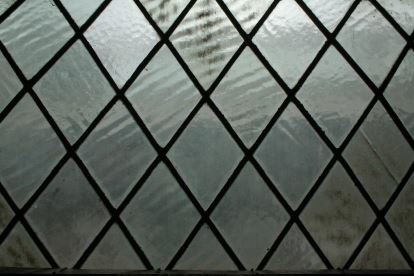 This glass was introduced to England in 1674 and remained popular until the 1830s. Also a blown glass, crown glass was blown into a bubble which was pierced by a rod and then spun to form a disk. The glass was cooled and then cut into panes. The centre piece, where the rod was attached, was usually discarded, although you occasionally see panes of that type in older homes. Crown glass was finer and clearer than broad glass. Although crown glass provided a less distorted view than previously produced window glasses, it still had a slight ripple to it.
This glass was introduced to England in 1674 and remained popular until the 1830s. Also a blown glass, crown glass was blown into a bubble which was pierced by a rod and then spun to form a disk. The glass was cooled and then cut into panes. The centre piece, where the rod was attached, was usually discarded, although you occasionally see panes of that type in older homes. Crown glass was finer and clearer than broad glass. Although crown glass provided a less distorted view than previously produced window glasses, it still had a slight ripple to it.
During the late 18th and early 19th centuries, crown glass was produced alongside the cylinder type, but it was eventually pushed out of production and the technique for making crown glass was lost. Today, the closest one can get to crown glass is cylinder glass.
Cylinder sheet glass
In a method similar to creating broad glass, cylinder sheet glass starts its life with the same blown glass technique but then the cylinder was swung in a trench to increase its size. As with broad glass, this larger cylinder is then cooled and cut before being reheated and flattened. As well as allowing larger panes to be made, the resulting product also provides a superior surface quality compared to broad glass.
Cast glass
Cast glass is a product of the late 17th century and created by pouring molten glass into a mould. The cast glass process is used for multiple purposes, including creating glass sculptures and mirror glass. Because the process is labour intensive, in glazing applications cast glass is typically reserved for statement windows – often including a texture or design.
Drawn glass
Invented by Emile Fourcault in 1904, the drawn glass process places a slot in a tank of molten glass and then ‘draws’ sheets of glass through it over water-cooled rollers and into a cooling chamber.
Around the same time, Irving Colburn introduced the Colburn machine, which used paper making as its inspiration. The sheet of glass is first drawn vertically from the surface of the molten glass and then gradually bent over a roller until it lays horizontally.
Glass produced by both of these methods was marked with ripples where it has been pulled and then rolled and, as with earlier processes, the glass had to be ground and polished afterwards.
Float glass
The process for making float glass was introduced by Alastair Pilkington in 1959, and it is still the industry standard today. With this process, the molten glass is poured onto a bed of molten tin. Floating on the tin, the molten glass spreads out to form a level surface.
Originally, Pilkington’s process enabled glass only to be made at 6.8 mm thick, but today it can be as thin as 0.4 mm or as thick as 25 mm. While the principles of the process remain unchanged, the surface quality of the glass has greatly improved, providing an end product devoid of distortions and/or flaws.
The introduction of the float process opened the doors to an architectural revolution that allowed very large panes of perfect glass to be created. Additional improvements since then have enabled increased and varied functionality and the further development of what is known as intelligent glazing.
Today’s windows are designed with a focus on U-values and energy efficiency. There are a variety of framing materials and glazing types that can be chosen; each contributing varying factors which can be combined to best suit climate and purpose.
Modern windows - materials and glazing types
 Today’s windows are designed with a focus on U-values and energy efficiency. There are a variety of framing materials and glazing types that can be chosen; each contributing varying factors which can be combined to best suit climate and purpose.
Today’s windows are designed with a focus on U-values and energy efficiency. There are a variety of framing materials and glazing types that can be chosen; each contributing varying factors which can be combined to best suit climate and purpose.
Window frames
The level of thermal resistance provided by framing material is a key contributor to the window’s overall energy efficiency, with some providing better thermal resistance than others.
Timber
Timber frames have been used for centuries and provide fairly decent insulation; however, wood tends to contract and expand according to weather conditions, which can cause problems. While initially more aesthetic than other types of window framing, timber framed windows require more maintenance than other framing types. That being said, applying vinyl or aluminium cladding can help reduce maintenance needs.
Composite
Composite frames are manufactured with composite wood materials like particle board and laminated strand lumber. Composite frames provide both superior thermal and structural performance over timber, as well as better resistance to moisture and decay.
Vinyl
Vinyl or PVC frames have a higher level of moisture resistance than timber and do not require painting – both factors that reduce maintenance requirements. Some vinyl frames also include hollow cavities that can be filled with insulation, which increases their thermal resistance. To prevent the vinyl or PVC from breaking down, these types of frames need to be treated with ultraviolet light stabilisers.
Fibreglass
 Fibreglass frames come equipped with air cavities that can be filled with insulation, and the material is naturally stable, eliminating the need for UV stabilisers.
Fibreglass frames come equipped with air cavities that can be filled with insulation, and the material is naturally stable, eliminating the need for UV stabilisers.
Aluminium, metal
The benefit of aluminium or metal windows is that it provides framing that is light yet very strong and is virtually maintenance free. The downside of aluminium framing is in its poor thermal resistance. This why aluminium framed windows need to have thermal breaks, i.e. insulating plastic strips positioned in-between the frame and the sash.
Glazing
The type of glazing used for a window is determined by evaluating several factors, including: local climate, window orientation, building design, and desired result. Some modern glazing types include:
Insulated
Insulated glazing typically refers to double or triple glazing, where two or more panes are spaced a distance apart and hermetically sealed, creating an insulating air space in-between each pane.
Gas-filled
In gas-filled double or triple glazed windows, instead of air, the space is filled with argon or krypton gas, which provides a superior resistance to heat flow.
Heat-absorbing tinted, reflective
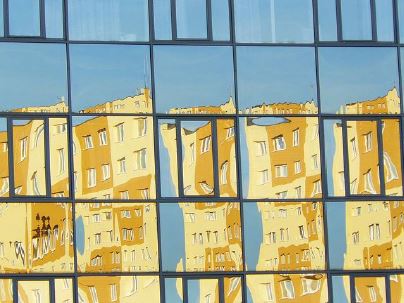 Tinted glass reduces the solar heat glaze coefficient, visible transmittance, and glare; however, it does not lower a window’s U-value. To address U-values, tinted glass must be heat treated – inner layers of glass can be added and special coatings can be applied to insulated glass to reduce thermal stress, high levels of which can result in breakage. One of the problems associated with tinted heat-absorbing glass is that, in addition to absorbing heat, it also blocks light.
Tinted glass reduces the solar heat glaze coefficient, visible transmittance, and glare; however, it does not lower a window’s U-value. To address U-values, tinted glass must be heat treated – inner layers of glass can be added and special coatings can be applied to insulated glass to reduce thermal stress, high levels of which can result in breakage. One of the problems associated with tinted heat-absorbing glass is that, in addition to absorbing heat, it also blocks light.
Reflective glass usually consists of a thin metallic coating that helps control solar heat gain. Because reflective glass typically blocks more light than heat, it is typically reserved for special applications, e.g. in museum galleries to protect collections from damaging UV light.
Low-E and spectrally selective
Low-E glazing refers to insulating glazing that includes a low emissivity coating to control heat transfer. The result is lowered U-values and, based upon the type of low e-coating, low, moderate, or high solar gain. Low-e coatings can be applied during the manufacturing process or after-the-fact on already-fitted windows. Typically, DIY low-e coatings last about 10 to 15 years on average. Spectrally selective low-e coatings filters out up to 70% of the heat that is typically let through by standard insulated glazing without blocking the amount of light entering into the interior space.
Intelligent glazing
While we have mentioned some of the most widely used types of modern glazing, today’s glazing technologies provide a wealth of options. For instance, some types of solar control smart glass respond to environmental conditions, automatically adapting to the light or heat that is being applied. Others can provide privacy/security at the flick of a switch – going from transparent to completely opaque within seconds. Other features of intelligent glazing include: noise mitigation, security, fire-resistance, condensation mitigation, selfcleaning, and solar collection.
This short article was repurposed from 'Windows, glass, glazing - a brief history' written for the Construction Information Service.
Interested in construction products and technologies? Make sure you don't miss out by signing up to receive the NBS eWeekly newsletter. Get the latest content from theNBS.com carefully crafted into a handy weekly email.
Sign up to the NBS eWeekly newsletter


